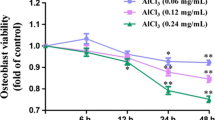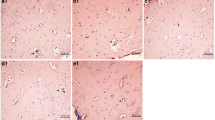Abstract
Aluminum promotes osteoblast (OB) apoptosis. Apoptosis is induced by the disordered calcium homeostasis. Therefore, to investigate the relationship between Al-induced OB apoptosis and calcium homeostasis, calvarium OBs from neonatal rats (3–4 days) were cultured and exposed to 0.048-mg/mL Al3+ or 0.048-mg/mL Al3+ combined with 5 μM BAPTA-AM (OBs were pretreated with 5 μM BAPTA-AM for 1 h, then added 0.048 mg/mL Al3+), respectively. Then OB apoptosis rate, intracellular calcium ions concentration ([Ca2+]i), mRNA expression level of calmodulin (CaM), and protein expression levels of CaM and p-CaMKII in OBs were examined. The result showed that AlCl3 increased OB apoptosis rate, and [Ca2+]i and p-CaMKII expression levels and decreased CaM expression levels, whereas BAPTA-AM relieved the effects. These results proved that AlCl3 induced OB apoptosis by disrupting the intracellular Ca2+ homeostasis and activating the Ca2+/CaMKII signal pathway. Our findings can provide new insights for revealing the apoptosis mechanism of OBs exposed to AlCl3.





Similar content being viewed by others
References
Hellström HO, Mjöberg B, Mallmin H, Michaëlsson K (2005) The aluminum content of bone increases with age, but is not higher in hip fracture cases with and without dementia compared to controls. Osteoporos Int 16:1982–1988
Bohrer D, Bertagnolli DC, de Oliveira SM, do Nascimento PC, de Carvalho LM, Garcia SC, Arantes LC, Barros EJ (2009) Role of medication in the level of aluminium in the blood of chronic haemodialysis patients. Nephrol Dial Transplant 24:1277–1281
Li X, Hu C, Zhu Y, Sun H, Li Y (2011) Effects of aluminum exposure on bone mineral density, mineral, and trace elements in rats. Biol Trace Elem Res 143:378–385
Smith AJ, Faugère MC, Abreo K, Fanti P, Julian B, Malluche HH (1986) Aluminum-related bone disease in mild and advanced renal failure: evidence for high prevalence and morbidity and studies on etiology and diagnosis. Am J Nephrol 6:275–283
Malluche HH, Faugere MC (1990) Renal bone disease 1990: an unmet challenge for the nephrologist. Kidney Int 38:193–211
Malluche HH, Faugere MC, Smith Jr AJ, Friedler RM (1986) Aluminum intoxication of bone in renal failure–fact or fiction? Kidney Int Suppl 18:70–73
Faugere MC, Arnala IO, Ritz E, Malluche HH (1986) Loss of bone resulting from accumulation of aluminum in bone of resulting from accumulation in bone of patients undergoing dialysis. J Lab Clin Med 107:481–487
Li XW, Han YF, Guan Y, Zhang L, Bai CS, Li YF (2012) Aluminum induces osteoblast apoptosis through the oxidative stress-mediated JNK signaling pathway. Biol Trace Elem Res 150:502–508
Jin Z, El-Deiry WS (2005) Overview of cell death signaling pathways. Cancer Biology & Therapy. 4(2):147–171
Orrenius S, Jr MCM, Nicotera P (1992) Ca(2+)-dependent mechanisms of cytotoxicity and programmed cell death. Toxicology Letters, 64–65 spec no(2):357–364
Orrenius S, Zhivotovsky B, Nicotera P (2003) Regulation of cell death: the calcium-apoptosis link Nat. Rev Mol Cell Biol 4:552–565
Quintana, A., Griesemer, D., Schwarz, E. C., Hoth, M. (2005). Calcium-dependent activation of t-lymphocytes. Pflugers Arch, 450(1), 1-12.
Pathak N, Mitra S, Khandelwal S (2013) Cadmium induces thymocyte apoptosis via caspase-dependent and caspase-independent pathways. J Biochem Mol Toxicol 27:193–203
Bootman MD, Lipp P, Berridge MJ (2001) The organisation and functions of local Ca2+ signals. J.Cell Sci. 114:2213–2222
Oberto A, Marks N, Evans HL (1996) Lead (Pb+2) promotes apoptosis in newborn rat cerebellar neurons: pathological implications. J Phamacol Exp Ther 279:435–442
Azzouzi B, Tsangaris GT, Pellegrini O, Manuel Y, Benveniste J, Thomas Y (1994) Cadmium induces apoptosis in a human T cell line. Toxicology 88:127–139
Yang PM, Chen HC, Tsai JS, Lin LY (2007) Cadmium induces Ca2+-dependent necrotic cell death through calpain-triggered mitochondrial depolarization and reactive oxygen species-mediated inhibition of nuclear factor-κB activity. Chem Res Toxicol 20:406–415
Xie Z, Zhang Y, Li A, Li P, Ji W, Huang D (2010) Cd-induced apoptosis was mediated by the release of Ca2+from intracellular Ca storage. Toxicol Lett 192:115–118
Liu W, Zhao HY, Wang Y, Jiang CY, Xia PP, Gu JH, Liu XZ, Bian JC, Yuan Y, Liu ZP (2014) Calcium–calmodulin signaling elicits mitochondrial dysfunction andthe release of cytochrome c during cadmium-induced apoptosis inprimary osteoblasts. Toxicol Lett 2:241–246
Jacobson MD, Weil M, Raft MC (1997) Programmed cell death in animal development. Cell 88:347–354
Chen QM, Tu VC (2002) Apoptosis and heart failure: mechanisms and therapeutic implications. Am J Cardiovase Drugs 2:43–57
Chin D, Means AR (2000) Calmodulin: a prototypical calcium sensor. Trends Cell Biol 10:322–328
Ermak G, Davies KJ (2002) Calcium and oxidative stress: from cell signaling to cell death. Mol Immunol 38:713–721
Colbran RJ (1992) Regulation and role of brain calcium/calmodulin-dependent protein kinase II. Neurochem Int 21:469–497
Solà C, Barrón S, Tusell JM, Serratosa J (2001) The Ca2+/calmodulin system in neuronal hyperexcitability. Int J Biochem Cell Biol 33:439–455
Liu Y, Templeton DM (2007) Cadmium activates CaMK-II and initiates CaMK-II-dependent apoptosis in mesangial cells. FEBS Lett 581:1481–1486
Matsuda SS, Silva TL, Buzalaf MA, Rodrigues AC, Oliveira RCD (2014) Differential effects of fluoride during osteoblasts mineralization in C57BL/6J and C3H/HEJ inbred strains of mice. Biol Trace Elem Res 161(1):123–129
Aronow MA, Gerstenfeld LC, Owen TA, Tassinari MS, Stein GS, Lian JB (1990) Factors that promote progressive development of the osteoblast phenotype in cultured fetal rat calvaria cells. J Cell Physiol 143:213–221
Alborzi A, Mac K, Glackin CA, Murray SS, Zernik JH (1996) Endochondral and intramembranous fetal bone development: osteoblastic cell proliferation, and expression of alkaline phosphatase, m-twist, and histone H4. J Craniofac Genet Dev Biol 16(2):94–106
Sudo H, Kodama HA, Amagai Y, Yamamoto S, Kasai S (1983) In vitro differentiation and calcification in a new clonal osteogenic cell line derived from newborn mouse calvaria. J Cell Biol 96:191–198
Salnikow K, Kluz T, Costa M (1999) Role of Ca2+ in the regulation of nickel-inducible Cap43 gene expression. Toxicol Appl Pharmacol 160:127–132
Kim YH, Fazlollahi F, Kennedy IM, Yacobi NR, Hamm-Alvarez SF, Borok Z, Kim KJ, Crandall ED (2010) Alveolar epithelial cell injury due to zinc oxide nanoparticle exposure. Am J Respir Crit Care Med 182:1398–1409
Sandhir R, Gill KD (1994) Effect of lead on the biological activity of calmodulin in rat brain. Exp Mol Pathol 61:69–75
Amarpreet K, Kiran DG (2005) Disruption of neuronal calcium homeostasis after chronic aluminium toxicity in rats. Basic. Clinical Pharmacology Toxicology. 96:118–122
Cheng G, Shan J, Xu G, Huang J, Ma J, Ying S, Zhu L (2003) Apoptosis induced by simvastatin in rat vascular smooth muscle cell through Ca2+-calpain and caspase-3 dependent pathway. Pharmacol Res 48:571–578
Sobczak A, Blazejczyk M, Piszczek G, Zhao G, Kuznicki J, Wojda U (2005) Calcium-binding calmyrin forms stable covalent dimers in vitro, but in vivo is found in monomeric form. Acta Biochim Pol 52:469–476
Pinton P, Giorgi C, Siviero R, Zecchini E, Rizzuto R (2008) Calcium and apoptosis: ER-mitochondria Ca2+ transfer in the control of apoptosis. Oncogene 27:6407–6418
Cyert MS (2001) Genetic analysis of calmodulin and its targets in Sacchromyces cerevisiae. Annu Rev Genet 35:647–672
Farnell BJ, Crapper McLachlan DR, Baimbridge K, De Boni U, Wong L, Wood PL (1985) Calcium metabolism in aluminium encephalopathy. Exp Neurol 88:68–83
Kawano T, Kadono T, Furuichi T, Muto S, Lapeyric F (2003) Aluminium-induced distortion of calcium signaling involving oxidative burst and channel regulation in tobacco BY-2 cells. Biochem Biophys Res Commun 308:35–42
Bliss TV, Collinggridge GL (1993) A synaptic model of memory: long-term potentiation in the hippocampus. Nature 361:31
Payne ME, Fong YL, Ono T, Colbran RJ, Kemp BE, Soderling TR, Means AR (1988) Calcium/calmodulin-dependent protein kinase II. Characterization of distinct calmodulin binding and inhibitory domains J Biol Chem 263:7190–7195
Fladmark KE, Brustugun OT, Mellgren G, Krakstadt C, BØe R, Vintermyr OK, Schulman H, DØskeland SO (2002) Ca2+/calmodulin-dependent protein kinase II is required for microcystin-induced apoptosis. J Biol Chem. 277:2804–2811
Krakstad C, Herfindal L, Gjertsen BT, BØe R, Vintermyr OK, Fladmark KE, DØskeland SO (2006) CaM-kinase II-dependent commitment to microcystin induced apoptosis is coupled to cell budding, but not to shrinkage or chromatin hypercondensation. Cell Death Differ 13:1191–1202
Sánchez-Piris M, Posas F, Alemany V, Winge I, Hidalgo E, Bachs O, Aligue R (2002) The serine/threonine kinase Cmk2 is required for oxidative stress response in fission yeast. J Biol Chem. 277:17722–17727
Odagiri K (2009) Local control of mitochondrial membrane potential, permeability transition pore and reactive oxygen species by calcium and calmodulin in rat ventricular myocytes. J Mol Cell Cardiol 46:989–997
Acknowledgment
The following are contract grant sponsors: National Science Foundation Project (contract grant number: 31372375) and Science and Technology Program of Heilongjiang Educational Bureau (contract grant number: C201425).
Author information
Authors and Affiliations
Corresponding author
Additional information
Zheng Cao and Dawei Liu contributed equally to this study.
Rights and permissions
About this article
Cite this article
Cao, Z., Liu, D., Zhang, Q. et al. Aluminum Chloride Induces Osteoblasts Apoptosis via Disrupting Calcium Homeostasis and Activating Ca2+/CaMKII Signal Pathway. Biol Trace Elem Res 169, 247–253 (2016). https://doi.org/10.1007/s12011-015-0417-1
Received:
Accepted:
Published:
Issue Date:
DOI: https://doi.org/10.1007/s12011-015-0417-1




